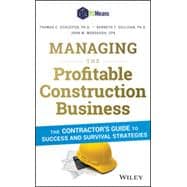Take control of your construction contracting business and manage it through the natural highs and lows of the construction market.
Learn from a team of construction business veterans led by Thomas C. Schleifer, who is commonly referred to as a construction business "turnaround" expert due to the number of construction companies he has rescued from financial distress. His financial acumen, combined with his practical, hands-on experience, has made him a sought-after private consultant. His experience and no-nonsense philosophy have truly given him a unique perspective. Important topics covered include:
- Understanding the primary areas of construction business failure in the next decade
- Minimizing business risk with real-world examples
- Developing a positive and competent management attitude and strategy








